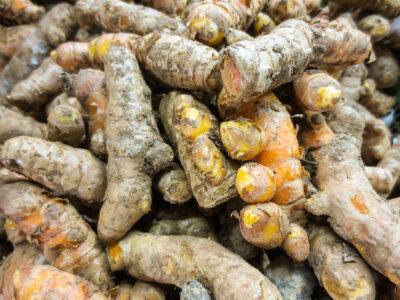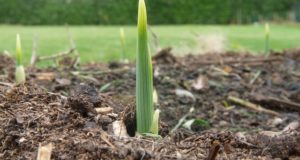For centuries, people have used turmeric as a medicinal herb and a cooking spice. Today, herbalists recommend turmeric and turmeric tea blends to aid in the relief of inflammatory conditions, aches, pains and gastrointestinal problems.
One of the active components in turmeric is curcumin. Curcumin is obtained from the dried rhizome of the turmeric plant, and it has been found to reduce inflammation and stiffness related to arthritis and joint pain.
The good news is that it is possible to grow turmeric at home ─ indoors or outdoors ─ so that you can harvest the root yourself! If you would love to have a constant, fresh supply of turmeric root, then this is the way to go!
Since cold weather is soon approaching, let’s focus on growing turmeric indoors.
1. Attain turmeric root
Turmeric doesn’t propagate seeds and is grown from rhizomes (root cuttings). Therefore, all you need is one turmeric root, which you can buy at a local nursery or online.
2. Break up the rhizome
Break larger rhizome into smaller pieces. Make sure each piece has a bud or two on it.
3. Use a large pot
Start off with a pot large enough to grow a nice root system. The larger the pot, the larger the root will grow. This, of course, will depend on how much indoor space you have. Make sure your pots have drainage holes so that the soil will drain well. Fill your pot with slightly moistened, rich, organic soil.
4. Planting
Plant the rhizomes two inches beneath the soil, making sure that the buds are facing up. Turmeric prefers sunlight but will grow under artificial grow lights.
5. Water
Turmeric grows better when it is kept moist, especially in hot climates. Water it about every two days, and spray it with a mist bottle between waterings. When the weather is cold, you will not need to water it as often. You always want the soil to be moist, but never soggy!
6. Fertilize:
Fertilize your turmeric plant twice a month. You can use organic fertilizer or make your own compost.
When Is Harvest Time?
One downside to growing turmeric is it takes about 8-10 months to mature. Furthermore, it is best to harvest the root in one entire piece.
It is best to maintain several plants, started at different times of the year so that you have a continuous supply of turmeric root.
Looking For Non-GMO Vegetable Seeds? Get Them From A Company You Can Trust!
After the 8-10 months, when you feel that the roots are large enough, it is time to dig them up.
Save a few pieces of the rhizome for re-potting. Change the soil, though, as the original plant more than likely depleted all the nutrients.
To process turmeric:
- Boil the rhizomes for about 45 minutes.
- Let them dry on a drying rack, in a cool, dry place for about one week.
- After the rhizomes are completely dry, peel them. You might want to wear gloves, as the dried root will turn your hands orange.
- After peeling, grind up the root into a fine powder to use as a spice or as a tea.
Fresh-Brewed, Turmeric Root Tea Recipe
What you will need
- For each cup of water, you will need two teaspoons of freshly grated turmeric root or two-thirds teaspoon of fresh-ground turmeric root.
- Raw honey.
- A wedge of fresh lemon.
- 1 teaspoon of flaxseed oil or coconut oil ─ or black pepper ─ to aid in the absorption of curcumin.
Preparation
- Bring the water to boil in a small pot.
- After the water is boiling, reduce to a simmer and blend in the turmeric root.
- Continue to simmer for 10 minutes. If you are using ground turmeric, simmer for an extra 5 minutes.
- Mix well, and then strain the turmeric from the tea.
- Add a wedge of lemon and honey to taste.
- Add the flaxseed oil, coconut oil or black pepper to aid in the absorption of curcumin.
Tumeric root tea is great for reducing aches and pains due to inflammation. It is suggested that you drink at least one to two cups of turmeric tea per day. However, there is not a standard amount for precise dosing.
Enjoy!
*This article is for informational purposes only and is not intended to diagnose or cure any particular health condition. Please consult with a qualified health professional first.
Have you ever grown turmeric indoors? Share your harvest tips in the section below:
Bust Inflation With A Low-Cost, High-Production Garden. Read More Here.
 Off The Grid News Better Ideas For Off The Grid Living
Off The Grid News Better Ideas For Off The Grid Living





